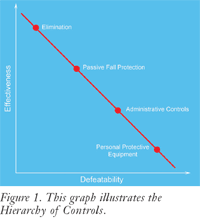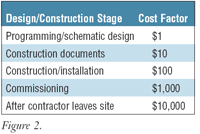Enhancing Safety Before Breaking Ground
- By Michael Behm, CSP, Thomas Kramer, Kimberly Messer
- Mar 01, 2008
“The safety of any operation is determined
long before the people, procedures,
and equipment come together at
the work site.”
—J. Stephenson, 1991
 Although the concept of proactively
creating safe construction sites is
widely agreed upon, achieving this
reality has been traditionally lacking in
execution. By combining the knowledge
of professionals in both the construction
and design facets of a project, safety can
be enhanced before crews ever break
ground. Doing this will yield a positive
impact on not only worker safety, but also
quality and productivity. Costs are lowered,
task performance is improved, and
life-threatening work hazards are reduced.
Although the concept of proactively
creating safe construction sites is
widely agreed upon, achieving this
reality has been traditionally lacking in
execution. By combining the knowledge
of professionals in both the construction
and design facets of a project, safety can
be enhanced before crews ever break
ground. Doing this will yield a positive
impact on not only worker safety, but also
quality and productivity. Costs are lowered,
task performance is improved, and
life-threatening work hazards are reduced.
Construction Safety
In the construction sector, occupational
fatalities have long been disproportionate
relative to the employment. For example,
in 2004, the construction industry
employed 7 percent of the workforce yet
accounted for 23 percent of all workrelated
fatalities in the United States
(Bureau of Labor Statistics, 2004;
NIOSH, 2004). One concept to reverse
this trend is to involve architects, design
engineers, and safety consultants in considering
construction safety during the
design process.
Internationally—most notably in
Europe and Australia—designing for
construction safety and health (DfCSH)
has been recognized and implemented as
a regulation and a feasible method to
reduce construction worker risk. Unfortunately,
however, its implementation in
the United States is commonly limited to
those situations where design and engineering
are closely partnered to construction
activities through procurement,
contract, and firm type.
While most contractors are committed
to safety on the job site, there is great
potential in engaging the design community
to participate in designing risk out of
the project from the start, as suggested by
the safety Hierarchy of Controls. The
Hierarchy of Controls compares the
effectiveness and “defeatability” of various
hazard abatement solutions. Waiting until
construction begins can limit your abatement
choices to the lowest levels of the
Hierarchy of Controls.
DfCSH TOOLS
In addition to efforts put forth through the
NIOSH PtD and the OSHA Design for Safety
Workgroup, the following tools have been
developed to help professionals incorporate
safety into the design phase of a construction
project.
Construction Industry Institute Toolbox
Gambatese et al (1997) engaged in a research
effort that has identified and developed more
than 400 design suggestions to enhance construction
safety. The accumulated
suggestions reflect all
types of design disciplines, job
site hazards, and construction
components and systems. A
computer program titled
“Design for Construction
Safety ToolBox,” developed in
conjunction with the Construction
Industry Institute, incorporates
the design suggestions
accumulated. The
program alerts the user to project-
specific construction
safety hazards and provides suggestions to
eliminate or reduce those hazards during the
design phase. The program is user-friendly,
applicable to any size or type of project, and
not only focuses on facility planning and
design aspects that affect construction phase
safety, but also can be applied to the start-up,
maintenance, and decommissioning phases. 
Construction Hazard Assessment
Implication Review (CHAIR) WorkCover, the occupational safety and health
regulatory authority of the State of New South
Wales, Australia, led the development of a
safety in design tool called Construction
Hazard Assessment Implication Review
(CHAIR). CHAIR’s goal is to identify risks in a
design as soon as possible in the life of a project.
The system considers construction, operations,
and maintenance activities. CHAIR provides
a framework for a facilitated discussion
that is stimulated by guidewords or prompts.
These prompts assist the key stakeholders in
collectively identifying and reducing construction,
maintenance, repair, and demolition
safety risks associated with a
design. This process specifies
that all stakeholders review the
design in a prescribed and
facilitated method to ensure the
occupational safety and health
issues of these stakeholders
are considered in the design
phase of the project. It includes
a conceptual design review
(CHAIR 1) and a detailed
design review for construction
(CHAIR 2) and maintenance
activities (CHAIR 3). |
Why Care about Design?
The European Foundation for the
Improvement of Living and Working
Conditions reported an initial attempt at
determining the extent to which the
design and the design process are linked
to construction accidents. By reviewing
construction fatalities, the report concluded
that about 60 percent of fatal accidents
in construction arise from decisions
made “upstream” from the construction
site. The research asserts that these fatal
accidents are due to shortcomings in
design and organization of the work. In a
more recent study, Behm (2005) sought to
link the design for construction safety
concept to construction fatalities through
a review of fatality incidents in the United
States. Of the 224 fatality cases reviewed,
the design was linked to the incident in
approximately 42 percent of the cases.
Designing for Construction
Safety and Health
DfCSH is defined as the deliberate consideration
of construction site safety in the
design phase of a construction project. The
DfCSH concept is a form of project risk
sharing in which the design professional
and the owner become involved in facilitating
construction site safety at the earliest
stages of the project’s life cycle. Specifically,
this encompasses the following:
• Modifications to the permanent
features of the construction project in
such a way that construction site safety
is considered
• Preparation of plans and specifications
for construction in such a way that
construction site safety is considered
• Utilization of specific design for
construction safety suggestions (see the
“DfCSH Tools” sidebar on page 68)
• Communication of risks regarding
the design in relation to the site and the
work to be performed.
Although DfCSH is not regulated in
the United States, the National Institute
for Occupational Safety and Health and
OSHA have been very responsive to the
concept. Hosted by NIOSH, the first Prevention
through Design (PtD) workshop
was held in July 2007 to launch a national
initiative aimed at eliminating occupational
hazards and controlling risks to
workers as early as possible in the life cycle
of items or workplaces. PtD includes the
design of work premises, structures, tools,
plants, equipment, machinery, substances, work methods, and systems of work.
OSHA is also taking a lead in getting
DfCSH tools and methods out to the
public. Its Alliance with the American
Society of Civil Engineers benefits the
construction industry and has focused an
effort on enhancing safety through design.
The Design for Safety workgroup is
actively promoting the concept and has
developed instructional presentations
regarding DfCSH. The OSHA-ASCE
Alliance also maintains a DfCSH Web site
with links to examples and information,
which can be found at www.designfor
constructionsafety.org.
A study conducted by an international
consumer-goods company showed that
implementing safety measures during the
programming and schematic design
phases of a project resulted in substantially
lower costs than implementing systems
during or after construction.
Figure 2 details cost factors involved in
the implementation of safety over the
course of a project.
When safety is implemented during
the programming/schematic design phase,
safety is incorporated from the beginning.
The Hierarchy of Controls (Fig. 1) can be
optimized by evaluating a system’s
“defeatability” and long-term cost comparisons.
Avoidance of interferences, connection
details, layout issues, and required
clearances are incorporated into the original
design. At this point, the designer
does not even need to erase lines on the
drawings—the safety aspects are simply
programmed into the design. This represents
a base cost to abate the hazard.
 At the other end of the spectrum, if
hazard abatement does not take place
until after contractors have left the site,
the following costs may be applied:
At the other end of the spectrum, if
hazard abatement does not take place
until after contractors have left the site,
the following costs may be applied:
• Base cost
• Cost of design
• Cost of additional drawing set for
hazard abatement
• Contractor mobilization
• Potentially significant field modifications
• Potentially significant rework of
interferences
• Long-term cost of not using ideal
abatement method
• Cost associated with using an
abatement method with higher risk.
Considering safety during the design
phase is an economical way of doing business.
The point is not how much it costs if
you wait until the end, but rather how
little it will cost the earlier you implement
it. It reduces injuries, illnesses, and
damage to the environment. Additionally,
using this approach ensures that business
owners will avoid expensive retrofitting,
reducing overall operating costs.
This article originally appeared in the March 2008 issue of Occupational Health & Safety.